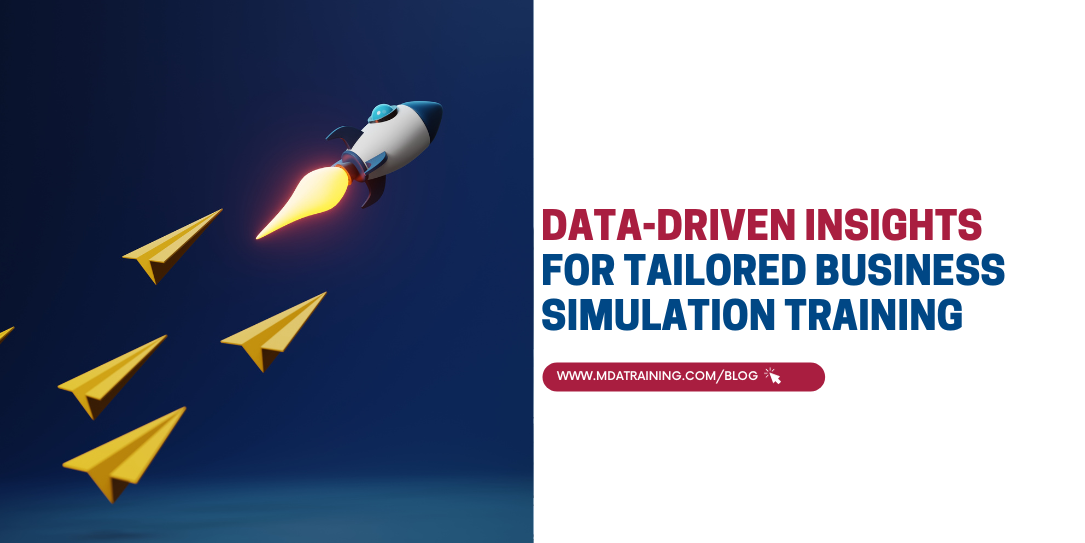“Without data, you’re just another person with an opinion.” – W. Edwards Deming
Business Simulation Training In today’s rapidly evolving world, the adage “Knowledge is Power” has evolved into “Data-Driven Knowledge is Absolute Power“. Learning & Development (L&D) sector has been no exception to this transformation. One of the most revolutionary intersections between data and L&D sector has been in the arena of business simulation training.
The Power of Personalised Learning

Gone are the days of one-size-fits-all learning programmes. Today, L&D professionals understand the importance of tailoring learning experiences to individual needs. According to the 2019 Training Industry Report, 91% of companies use some form of personalised learning techniques. But how does data fuel this drive?
1. Setting the Stage: The L&D Transformation
“Change is the end result of all true learning.” – Leo Buscaglia
L&D has evolved, with businesses recognising that personalised learning isn’t just a luxury—it’s a necessity. According to LinkedIn’s 2020 Workplace Learning Report, 51% of companies are exploring personalised learning paths, recognising their potential to enhance productivity and engagement.
2. Business Simulation Training: More Than Just a Game
Business simulation training—often interactive, scenario-based modules—allow learners to practise skills in risk-free environments. A Harvard Business Review article highlights how simulations provide safe spaces for learners to fail, learn, and iterate, bridging the gap between knowledge and its practical application
3. The Crucial Intersection: Data and Personalisation
When business simulation meets robust data analytics, the outcome is a highly tailored learning experience. Here’s how it works:
- Learner Analytics: Gathering insights about an individual’s learning pace, strengths, and areas needing improvement. Tools like xAPI (Experience API) are helping businesses track and analyse granular data about learner behaviours.
- Feedback Loops: Real-time adjustments based on performance. Systems embedded within simulations can adapt scenarios based on immediate prior responses.
- Predictive Analysis: By harnessing data from past and current performance, simulations can anticipate future learning needs. This can also help in forecasting industry-specific challenges, equipping learners with requisite skills ahead of time.
4. Real-world Impact of Data-Driven Simulation Training
Case Study: Walmart’s VR Employee Training Initiative
Walmart, the world’s largest retailer, has always been at the forefront of adopting innovative techniques to enhance its operations. In the realm of employee training, Walmart made headlines by integrating Virtual Reality (VR) into its training regimen.
The Premise
Back in 2017, Walmart announced its collaboration with STRIVR, a VR training platform, to bring VR instruction to its 200 training centres. Initially used to teach employees about the nuances of Black Friday’s customer rush, the VR training program has since been expanded to cover more scenarios.
The Role of Data
Walmart’s VR training modules are not just about immersive experience; they are also about collecting data:
- Performance Metrics: STRIVR’s platform records data points during training sessions, such as where employees spend the most time looking, how they respond to different challenges, and their decision-making speed.
- Tailored Training: Using these metrics, the training can be adapted to suit individual needs, ensuring that every employee has a tailored learning path.
- Instant Feedback: Post the VR scenario, employees receive immediate feedback on their performance, backed by the data collected during the session. This helps in identifying areas of improvement.
The Outcome
Through its VR training program, Walmart witnessed several tangible benefits:
- Improved Retention: Employees reportedly had a 10-15% better retention rate from VR training compared to traditional methods, as per Andy Trainor, Walmart’s senior director of Walmart U.S. Academies.
- Real-world Preparation: The training modules, especially those simulating high-pressure scenarios like Black Friday, prepared employees much better for actual in-store situations.
- Scalability: With the success of the initial program, Walmart decided to send VR training kits to all its U.S. stores, amounting to over 17,000 Oculus Go headsets, to make the training more accessible.
Wrapping Up
Walmart’s foray into VR-based employee training is a clear testament to the potential of blending immersive tech with data-driven strategies. This initiative not only underscores the importance of innovative L&D methods but also how these methods can be scaled for a large workforce, ensuring consistency and quality across the board.
5. Benefits and Challenges of Harnessing Data in Simulation Training
Benefits:
- Relevance: Training becomes more in-tune with individual needs.
- Efficiency: Time is optimally utilised, focusing on areas of improvement.
- Predictive Power: Prepares the workforce for anticipated challenges.
Challenges:
- Data Privacy Concerns: Handling personal data mandates stringent privacy regulations adherence.
- Over-Reliance on Data: While data is crucial, human touch and judgement remain irreplaceable.
- Keeping Simulations Updated: As industries evolve, ensuring simulations mirror real-world scenarios is vital.
What’s Next?
Employing comprehensive data analytics in business simulation training heralds a new era in L&D — one that’s tailored, forward-thinking, dynamic, and deeply transformative. As companies worldwide adopt this innovative approach, the horizons of what can be achieved in L&D are being redefined. With MDA Training’s expertise, you can seamlessly integrate these advanced methods into your training programmes.

Ready to elevate your training approach? Reach out to MDA Trainers and train your team today.



















